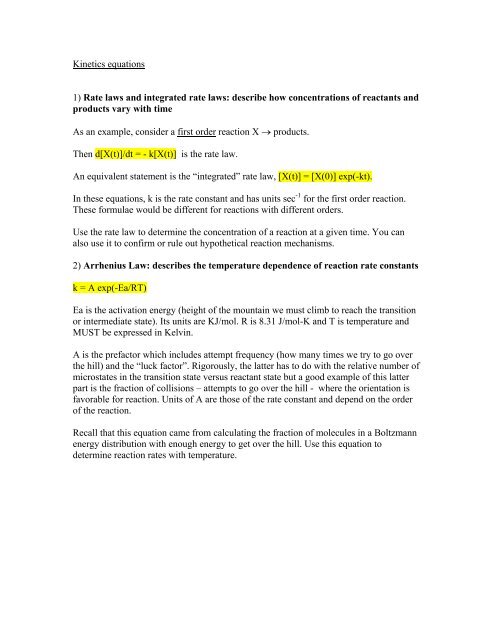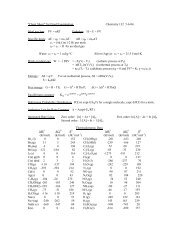Equations we use in Chem 132 - Chemistry
Equations we use in Chem 132 - Chemistry
Equations we use in Chem 132 - Chemistry
Create successful ePaper yourself
Turn your PDF publications into a flip-book with our unique Google optimized e-Paper software.
K<strong>in</strong>etics equations1) Rate laws and <strong>in</strong>tegrated rate laws: describe how concentrations of reactants andproducts vary with timeAs an example, consider a first order reaction X → products.Then d[X(t)]/dt = - k[X(t)] is the rate law.An equivalent statement is the “<strong>in</strong>tegrated” rate law, [X(t)] = [X(0)] exp(-kt).In these equations, k is the rate constant and has units sec -1 for the first order reaction.These formulae would be different for reactions with different orders.Use the rate law to determ<strong>in</strong>e the concentration of a reaction at a given time. You canalso <strong>use</strong> it to confirm or rule out hypothetical reaction mechanisms.2) Arrhenius Law: describes the temperature dependence of reaction rate constantsk = A exp(-Ea/RT)Ea is the activation energy (height of the mounta<strong>in</strong> <strong>we</strong> must climb to reach the transitionor <strong>in</strong>termediate state). Its units are KJ/mol. R is 8.31 J/mol-K and T is temperature andMUST be expressed <strong>in</strong> Kelv<strong>in</strong>.A is the prefactor which <strong>in</strong>cludes attempt frequency (how many times <strong>we</strong> try to go overthe hill) and the “luck factor”. Rigorously, the latter has to do with the relative number ofmicrostates <strong>in</strong> the transition state versus reactant state but a good example of this latterpart is the fraction of collisions – attempts to go over the hill - where the orientation isfavorable for reaction. Units of A are those of the rate constant and depend on the orderof the reaction.Recall that this equation came from calculat<strong>in</strong>g the fraction of molecules <strong>in</strong> a Boltzmannenergy distribution with enough energy to get over the hill. Use this equation todeterm<strong>in</strong>e reaction rates with temperature.
Electrochemistry equations:1) Relationship of Gibbs Free energy to electrical work∆G = -nFEElectrical work is QE where Q is the charge moved and E the potential drop it movesthrough. Here, Q is expressed <strong>in</strong> units of Coulombs as n, the number of moles ofelectrons transferred <strong>in</strong> a redox reaction, times the Faraday constant F, which is thenumber of Coulombs <strong>in</strong> a mole of electrons (F = 96,485 coul/mole). E is <strong>in</strong> Volts.∆G is the usual Gibbs free energy change for the redox reaction <strong>in</strong> units of KJ/mol.Note that 1 J = 1 coul x 1 Volt.We <strong>use</strong> this equation to relate what <strong>we</strong> learned <strong>in</strong> thermodynamics where ∆G was <strong>use</strong>d todeterm<strong>in</strong>e spontaneity and equilibrium constants to electrochemistry where potential is<strong>use</strong>d to describe the driv<strong>in</strong>g force <strong>in</strong> redox reactions.Note that s<strong>in</strong>ce n and F are always positive numbers, the criterion for spontaneity ∆G < 0translates to E > 0 for redox reactions.Use this equation when you want to translate potentials for redox reactions <strong>in</strong>to ∆G.2) Nernst equation: enables one to compute redox potential under non-standardconditions (temperature not 298 K and/or concentration not 1 M).E = E 0 – (0.0592/n) log 10 QE and E 0 are the cell potentials under non-standard and standard conditions respectivelyand are expressed <strong>in</strong> Volts.n is the number of moles of electrons transferred <strong>in</strong> the redox reaction (deduced from thestoichiometry of the reaction).Q is the reaction quotient.This equation comes directly from the equation ∆G = ∆G 0 + RT ln Q <strong>we</strong> <strong>use</strong>d <strong>in</strong>thermodynamics for non-standard conditions. It <strong>use</strong>s the relationship of ∆G to potential Eabove to convert this to an equation for potential under non-standard conditions. Theconstant 0.0592 is just (RT/F ln 10) where it has been assumed that T = 298 K and <strong>we</strong>have converted to base 10 logarithms. Thus, if you wanted to know cell potentials atother temperatures, you could <strong>use</strong> the more complicated form E = E 0 – (RT/n F) ln Q.The Nernst equation is <strong>use</strong>ful to calculate voltage from concentration (or vice versa) <strong>in</strong>galvanic cells or sometimes voltage versus time as concentration changes.
3) Equilibrium constants of redox reactions.log 10 K eq = n E 0 /0.0592This is just the Nernst equation expressed at equilibrium (where Q = K eq by def<strong>in</strong>itionand ∆G = -n F E = 0). Aga<strong>in</strong>, n is the number of moles of electrons transferred <strong>in</strong> theredox reaction and E 0 is the standard cell potential <strong>in</strong> Volts.This equation is <strong>use</strong>d to determ<strong>in</strong>e concentrations <strong>in</strong> galvanic cells when equilibrium isreached (i.e. when the redox reaction stops so the battery is dead).Note that another way to write this (see above where <strong>we</strong> have not assumed that T = 298K) is K eq = exp (n F E 0 /RT). This means that when n F E 0 is a few times RT, theredox reaction will essentially go to completion. Galvanic cells with potentials muchlarger than 0.0592 V will tend to end up completely reacted.Quantum mechanics equations:1) Relationship bet<strong>we</strong>en photon energy, frequency and wavelength:E = hν = hc/λLight behaves as discrete particles called “photons” <strong>in</strong> many circumstances (e.g.photoelectric effect). The properties of photons are expressed by this equation.E is the photon energy (standard units of Joules), h is Planck’s constant (6.63x10 -34 J-sec), ν is the frequency of the light <strong>in</strong> sec -1 (Hz) and λ its wavelength (<strong>in</strong> meters). Thespeed of light is given by c = 3x10 8 m/sec.2) DeBroglie wavelength:λ = h/mvIn this case, λ refers to the DeBroglie wavelength of a particle. Particles sometimesbehave as waves as for example <strong>in</strong> electron diffraction or electrons <strong>in</strong> atoms where theyexhibit the wave-like property of <strong>in</strong>terference. The particle mass (<strong>in</strong> kg) is represented bym and its velocity (m/s) by v. The significance of this equation is that it tells you when<strong>we</strong> need to th<strong>in</strong>k of particles as waves (i.e. when should <strong>we</strong> <strong>use</strong> the Schröd<strong>in</strong>ger equation<strong>in</strong>stead of Newton’s Laws to describe their behavior). When the wavelength of theparticle is comparable to or larger than the size of the system under study (for <strong>Chem</strong>istry,this means atomic dimensions), you need to <strong>use</strong> a quantum mechanical description andyou can expect particles to have wavelike properties. This is not an either/or situation –quantum mechanics always works and degenerates to Newton’s Laws for macroscopicobjects but it is not necessary to <strong>in</strong>voke its complexity when the DeBroglie wavelengthsare small compared to the system of <strong>in</strong>terest.
3) Heisenberg uncerta<strong>in</strong>ty pr<strong>in</strong>ciple:∆p∆x ≥ h/4πThis equation states that a particle’s momentum p and position x cannot be knownsimultaneously to better than a certa<strong>in</strong> precision. ∆p stands for the uncerta<strong>in</strong>ty <strong>in</strong>momentum (p = mv) and ∆x for the uncerta<strong>in</strong>ty <strong>in</strong> position. Once aga<strong>in</strong>, h is Planck’sconstant. You can th<strong>in</strong>k of this <strong>in</strong> two ways. One <strong>in</strong>terpretation is that the act ofmeasur<strong>in</strong>g one of these quantities changes the other so that it cannot be measured withgreater than a certa<strong>in</strong> precision. Another <strong>in</strong>terpretation is that these quantities really donot have precise mean<strong>in</strong>g simultaneously so that ask<strong>in</strong>g about a particle’s exact positionand velocity is just not a mean<strong>in</strong>gful question.4) Schröd<strong>in</strong>ger wave equationHψ = Eψ :(-h 2 /8π 2 m)d 2 ψ/dx 2 + V(x)ψ = EψHere H is a mathematical operator called the Hamiltonian. It has units of energy and ismeant to describe the total energy (k<strong>in</strong>etic plus potential) of a particle or set of particles.Aga<strong>in</strong>, h stands for Planck’s constant, m is the particle mass and x the particle position(this would be r <strong>in</strong> three dimensions). V(x) is the potential energy that the particle feels.For us <strong>in</strong> <strong>Chem</strong> <strong>132</strong>, the most important potential is the Coulomb potential (see below)describ<strong>in</strong>g the attraction of electrons to nuclei and <strong>in</strong>terelectron repulsion. We have alsoalluded to the harmonic potential <strong>use</strong>d for spr<strong>in</strong>gs (Hooke’s Law) describ<strong>in</strong>g bondvibrations of molecules. Typically, the <strong>in</strong>put to the Schrod<strong>in</strong>ger equation is V(x) and <strong>we</strong>solve for the allo<strong>we</strong>d energies E that the particle can have and the correspond<strong>in</strong>gwavefunctions ψ(x) that the particle can have. In general, ψ(x) is a complex number andits squared modulus |ψ(x)| 2 is proportional to the probability of f<strong>in</strong>d<strong>in</strong>g the particle at thelocation x. I would like to expla<strong>in</strong> to you why the Schröd<strong>in</strong>ger equation works and why|ψ(x)| 2 describes its location <strong>in</strong> a probabilistic way at a more fundamental level that is<strong>in</strong>tuitive but I can’t. I suggest treat<strong>in</strong>g it as a brute fact that it works and expla<strong>in</strong>sexperimental data exquisitely <strong>we</strong>ll.5) Bohr formulaE n = -Z 2 me 4 /(8n 2 h 2 ε 0 2 ) = 2.178 x 10 -18 (Z 2 /n 2 ) (<strong>in</strong> Joules)When <strong>we</strong> solve the Schröd<strong>in</strong>ger equation with the Coulomb potential V = -Ze 2 /4πε 0 r, theallo<strong>we</strong>d energies for an electron bound to a proton that <strong>we</strong> get are described by the aboveformula. We <strong>we</strong>re able to “derive” this formula by us<strong>in</strong>g Bohr’s idea that electrons travel<strong>in</strong> circular orbits and that the radii are selected by the criterion that the DeBrogliewavelength of the electron folds back onto itself. That assumption plus some classicalmechanics gave us the same result. This formula applies onto to one electron atoms likeH, He + , Li 2+ , etc. Z stands for the atomic number (number of protons <strong>in</strong> the nucleus) andn is an <strong>in</strong>teger (1,2,3, …) <strong>we</strong> call the pr<strong>in</strong>cipal quantum number. Remember that the case
where n = ∞ corresponds to a free electron (E ≡ 0) so that E 1 is also the ionization energyfor the hydrogenic atom <strong>in</strong> question.



